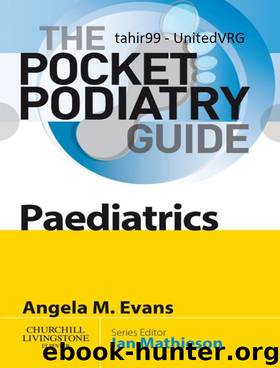Pocket Podiatry: Paediatrics by Evans Angela Margaret & Evans Angela Margaret

Author:Evans, Angela Margaret & Evans, Angela Margaret
Language: eng
Format: epub
ISBN: 978-0-7020-3031-4
Publisher: Elsevier Health Sciences UK
Published: 2010-01-25T16:00:00+00:00
Basic pathology
The congenital idiopathic clubfoot deformity is identified by the presence of a retracted and inverted heel (equinus), usually a medial crease on the plantar aspect of the adducted forefoot and longitudinal arch cavus. Pathognomonic to this deformity is the inability to be able to bring the foot to a plantigrade position. In unilateral cases, the clubfoot is comparatively stiff, smaller with leg muscle atrophy and shortening also common.
In terms of aetiology, a normally developing foot deforms at approximately the 16th fetal week to become a clubfoot. While genetics and environmental influences are both probable contributors, it is curious to note that a more precise mechanism(s) of aetiology is still unknown. The primary deformity centres on the shape and position of the talus and the related misplacement of the navicular.
The Ponseti method focuses on stabilizing the talus and reducing the clubfoot deformity by abducting the inverted forefoot. This allows for the calcaneus to abduct, which, in turn, allows for the ankle to be dorsiflexed (often necessitating lengthening of the Achilles tendon) (Pandey & Pandey 2003; Ponseti 1997; Ponseti et al 2003, 2006).
Download
This site does not store any files on its server. We only index and link to content provided by other sites. Please contact the content providers to delete copyright contents if any and email us, we'll remove relevant links or contents immediately.
Periodization Training for Sports by Tudor Bompa(8171)
Why We Sleep: Unlocking the Power of Sleep and Dreams by Matthew Walker(6618)
Paper Towns by Green John(5092)
The Immortal Life of Henrietta Lacks by Rebecca Skloot(4526)
The Sports Rules Book by Human Kinetics(4296)
Dynamic Alignment Through Imagery by Eric Franklin(4118)
ACSM's Complete Guide to Fitness & Health by ACSM(3989)
Kaplan MCAT Organic Chemistry Review: Created for MCAT 2015 (Kaplan Test Prep) by Kaplan(3940)
Introduction to Kinesiology by Shirl J. Hoffman(3726)
Livewired by David Eagleman(3685)
The Death of the Heart by Elizabeth Bowen(3553)
The River of Consciousness by Oliver Sacks(3542)
Alchemy and Alchemists by C. J. S. Thompson(3451)
Bad Pharma by Ben Goldacre(3357)
Descartes' Error by Antonio Damasio(3231)
The Emperor of All Maladies: A Biography of Cancer by Siddhartha Mukherjee(3068)
The Gene: An Intimate History by Siddhartha Mukherjee(3049)
The Fate of Rome: Climate, Disease, and the End of an Empire (The Princeton History of the Ancient World) by Kyle Harper(3006)
Kaplan MCAT Behavioral Sciences Review: Created for MCAT 2015 (Kaplan Test Prep) by Kaplan(2941)
